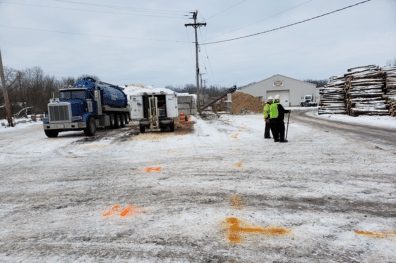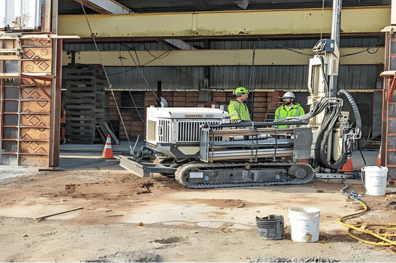ORIN conducted direct injection treatment to target groundwater contaminated with Acetochlor and Metolachlor using BAM, a pyrolized cellulosic material. The remedial footprint of the site is 11,400 ft2, ORIN used 120 DPT points to evenly distribute the treatment chemistry across the site. ORIN also installed 5 extraction wells spaced out across the site and used a vac truck to aid in treatment chemistry distribution by controlling the hydraulic gradient on the site.
The Challenge
The site presented specific contamination challenges:
- Agricultural Chemicals Present:
- Acetochlor: 56 μg/L
- Metolachlor: 6,300 μg/L
- Complex site geology including:
- Fill material (fine to medium sand)
- Sandy silt
- Silty clay
- Large remedial footprint of 11,400 ft²
The Solution: Integrated Treatment Approach
The remediation team implemented a comprehensive strategy combining:
- Direct Push Technology (DPT) Injection:
- 120 injection points strategically placed
- Even distribution across treatment area
- Utilized BAM, a pyrolized cellulosic material
- Hydraulic Control System:
- Installation of 5 extraction wells
- Strategic well placement across site
- Vacuum truck deployment for gradient control
- Enhanced treatment distribution
Innovative Treatment Chemistry
The project utilized BAM technology:
- Pyrolized cellulosic material
- Specifically designed for agricultural chemical treatment
- Even distribution through multiple injection points
- Enhanced by hydraulic control measures
Outstanding Results
The treatment achieved impressive contaminant reductions:
- Acetochlor: 90.9% reduction from initial levels
- Metolachlor: 85.5% reduction from initial levels
- Results confirmed through post-treatment sampling
Key Success Factors
Several elements contributed to the project’s effectiveness:
- Strategic placement of injection points
- Integration of hydraulic control measures
- Use of specialized BAM technology
- Comprehensive site coverage
- Controlled treatment distribution
Technical Innovation
The project demonstrated several innovative approaches:
- Combined use of DPT and extraction wells
- Hydraulic gradient control for enhanced distribution
- Strategic spacing of treatment points
- Integration of multiple treatment technologies
This case study provides valuable insights for similar agricultural chemical remediation projects, particularly those dealing with persistent pesticide compounds in complex geological settings.



